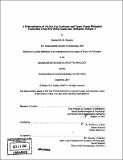| dc.contributor.advisor | William J. Jenkins. | en_US |
| dc.contributor.author | Stanley, Rachel H. R | en_US |
| dc.contributor.other | Woods Hole Oceanographic Institution. | en_US |
| dc.date.accessioned | 2008-09-03T15:11:28Z | |
| dc.date.available | 2008-09-03T15:11:28Z | |
| dc.date.copyright | 2007 | en_US |
| dc.date.issued | 2007 | en_US |
| dc.identifier.uri | http://hdl.handle.net/1721.1/42282 | |
| dc.description | Thesis (Ph. D.)--Joint Program in Chemical Oceanography (Massachusetts Institute of Technology, Dept. of Earth, Atmospheric, and Planetary Sciences; and the Woods Hole Oceanographic Institution), 2007. | en_US |
| dc.description | Includes bibliographical references (p. 215-225). | en_US |
| dc.description.abstract | The five noble gases (helium, neon, argon, krypton, and xenon) are biologically and chemically inert, making them ideal oceanographic tracers. Additionally, the noble gases have a wide range of solubilities and molecular diffusivities, and thus respond differently to physical forcing. Tritium, an isotope of hydrogen, is useful in tandem with its daughter helium-3 as a tracer for water mass ages. In this thesis, a fourteen month time-series of the five noble gases, helium-3 and tritium was measured at the Bermuda Atlantic Time-series Study (BATS) site. The time-series of five noble gases was used to develop a parameterization of air-sea gas exchange for oligotrophic waters and wind speeds between 0 and 13 m s-1 that explicitly includes bubble processes and that constrains diffusive gas exchange to ± 6% and complete and partial air injection processes to ± 15%. Additionally, the parameterization is based on weeks to seasonal time scales, matching the time scales of many relevant biogeochemical cycles. The time-series of helium isotopes, tritium, argon, and oxygen was used to constrain upper ocean biological production. Specifically, the helium flux gauge technique was used to estimate new production, apparent oxygen utilization rates were used to quantify export production, and euphotic zone seasonal cycles of oxygen and argon were used to determine net community production. The concurrent use of these three methods allows examination of the relationship between the types of production and begins to address a number of apparent inconsistencies in the elemental budgets of carbon, oxygen, and nitrogen. | en_US |
| dc.description.statementofresponsibility | by Rachel H.R. Stanley. | en_US |
| dc.format.extent | 225 p. | en_US |
| dc.language.iso | eng | en_US |
| dc.publisher | Massachusetts Institute of Technology | en_US |
| dc.rights | M.I.T. theses are protected by
copyright. They may be viewed from this source for any purpose, but
reproduction or distribution in any format is prohibited without written
permission. See provided URL for inquiries about permission. | en_US |
| dc.rights.uri | http://dspace.mit.edu/handle/1721.1/7582 | en_US |
| dc.subject | Joint Program in Chemical Oceanography. | en_US |
| dc.subject | Earth, Atmospheric, and Planetary Sciences. | en_US |
| dc.subject | Woods Hole Oceanographic Institution. | en_US |
| dc.subject.lcsh | Ocean-atmosphere interaction | en_US |
| dc.subject.lcsh | Radioactive tracers in oceanography | en_US |
| dc.subject.lcsh | Gases, Rare | en_US |
| dc.subject.lcsh | Biogeochemical cycles | en_US |
| dc.title | A determination of air-sea gas exchange and upper ocean biological production from five noble gasses and tritiugenic helium-3 | en_US |
| dc.type | Thesis | en_US |
| dc.description.degree | Ph.D. | en_US |
| dc.contributor.department | Joint Program in Chemical Oceanography | en_US |
| dc.contributor.department | Woods Hole Oceanographic Institution | en_US |
| dc.contributor.department | Massachusetts Institute of Technology. Department of Earth, Atmospheric, and Planetary Sciences | |
| dc.identifier.oclc | 232155135 | en_US |
